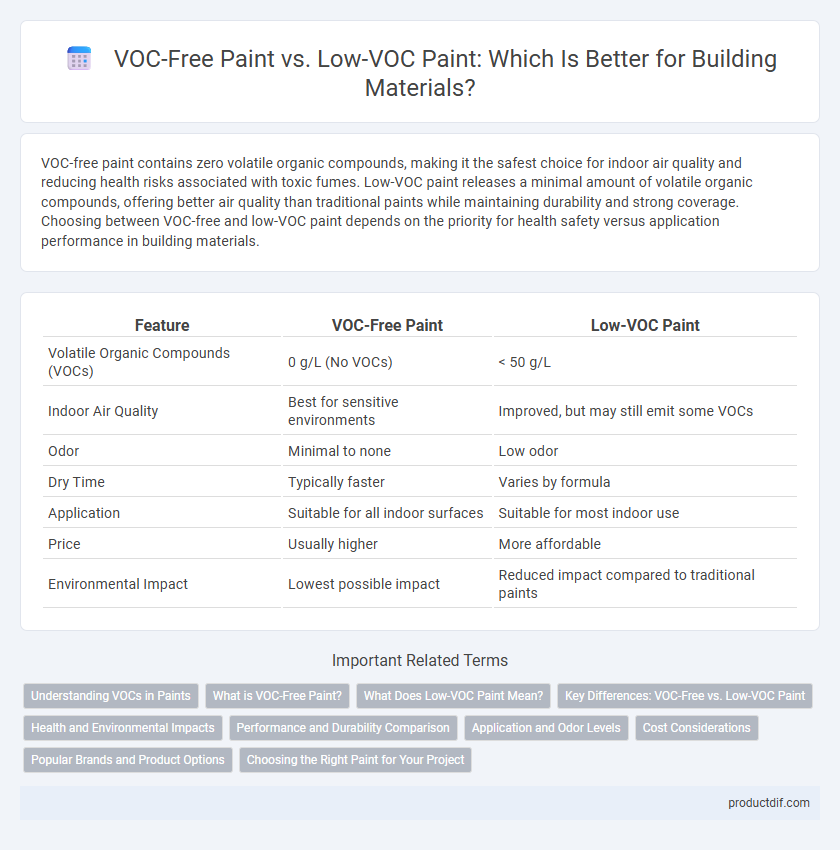VOC-free paint contains zero volatile organic compounds, making it the safest choice for indoor air quality and reducing health risks associated with toxic fumes. Low-VOC paint releases a minimal amount of volatile organic compounds, offering better air quality than traditional paints while maintaining durability and strong coverage. Choosing between VOC-free and low-VOC paint depends on the priority for health safety versus application performance in building materials.
Table of Comparison
| Feature | VOC-Free Paint | Low-VOC Paint |
|---|---|---|
| Volatile Organic Compounds (VOCs) | 0 g/L (No VOCs) | < 50 g/L |
| Indoor Air Quality | Best for sensitive environments | Improved, but may still emit some VOCs |
| Odor | Minimal to none | Low odor |
| Dry Time | Typically faster | Varies by formula |
| Application | Suitable for all indoor surfaces | Suitable for most indoor use |
| Price | Usually higher | More affordable |
| Environmental Impact | Lowest possible impact | Reduced impact compared to traditional paints |
Understanding VOCs in Paints
VOC-free paint contains little to no volatile organic compounds, significantly reducing indoor air pollution and health risks compared to low-VOC paint, which still emits small amounts of these chemicals. VOCs in paints contribute to harmful smog and pose respiratory concerns, making VOC-free options preferable for sensitive environments. Understanding the impact of VOCs helps in selecting paints that promote healthier indoor air quality and comply with environmental regulations.
What is VOC-Free Paint?
VOC-free paint contains no volatile organic compounds, ensuring zero emissions of harmful gases during and after application, which significantly improves indoor air quality. It is formulated with natural or synthetic ingredients that do not release toxic fumes, making it ideal for sensitive environments such as hospitals, schools, and homes with children or pets. Unlike low-VOC paints, which have reduced but still present emissions, VOC-free paints guarantee completely chemical-free air, promoting healthier living spaces.
What Does Low-VOC Paint Mean?
Low-VOC paint contains fewer volatile organic compounds than traditional paints, reducing harmful emissions during application and drying. It emits lower levels of chemicals like formaldehyde and benzene, improving indoor air quality and minimizing health risks such as headaches and respiratory issues. Choosing low-VOC paint supports eco-friendly building practices and complies with environmental regulations while providing durable, vibrant finishes.
Key Differences: VOC-Free vs. Low-VOC Paint
VOC-free paint contains zero volatile organic compounds, ensuring no harmful emissions and superior indoor air quality, while low-VOC paint limits VOC content to less than 50 grams per liter, reducing but not eliminating toxic fumes. VOC-free options are ideal for sensitive environments such as hospitals and schools, whereas low-VOC paints are suitable for general residential and commercial use with moderate health considerations. Key differences include emission levels, odor intensity, and environmental impact, with VOC-free products providing the safest, most eco-friendly solution.
Health and Environmental Impacts
VOC-free paint eliminates volatile organic compounds entirely, significantly reducing indoor air pollution and minimizing health risks such as respiratory irritation, headaches, and long-term chronic conditions. Low-VOC paint contains a limited amount of volatile organic compounds, offering reduced but not negligible emissions that can still contribute to indoor air quality issues and environmental harm. Choosing VOC-free paint supports better indoor air quality and lowers environmental impact by preventing the release of harmful chemicals into the atmosphere during application and drying.
Performance and Durability Comparison
VOC-free paint offers superior environmental safety by eliminating volatile organic compounds entirely, making it ideal for sensitive indoor environments, while maintaining competitive durability. Low-VOC paint contains limited amounts of volatile organic compounds, providing better performance in terms of adhesion and resistance to wear, often resulting in enhanced longevity under harsh conditions. Both options deliver acceptable durability, but low-VOC paints typically outperform VOC-free alternatives in high-traffic or outdoor applications due to their chemical composition.
Application and Odor Levels
VOC-Free paint offers a safer application process with zero harmful emissions, making it ideal for sensitive environments such as hospitals and schools. Low-VOC paint contains minimal volatile organic compounds, allowing for moderate ease of application but with noticeable, yet reduced, odors compared to traditional paints. Both options improve indoor air quality, but VOC-Free paint significantly reduces post-application odor levels, enhancing comfort during and after use.
Cost Considerations
VOC-Free paint typically incurs higher upfront costs due to specialized formulations and limited production scale, making it a premium choice for budget-sensitive projects. Low-VOC paint offers a more affordable alternative while still reducing harmful emissions, providing cost-effective compliance with environmental regulations. Long-term savings in health-related expenses and ventilation requirements can offset initial price differences between VOC-Free and Low-VOC paint options.
Popular Brands and Product Options
Popular brands offering VOC-free paint include Benjamin Moore's Natura and Zero-VOC lines, while low-VOC options are widely available from Sherwin-Williams' Harmony and Behr's Premium Plus Ultra. VOC-free paints typically provide a completely odorless, non-toxic solution ideal for sensitive environments, whereas low-VOC paints balance improved air quality with a broader color and finish selection. Both categories cater to eco-conscious consumers seeking safer indoor air quality but differ in chemical composition and price points.
Choosing the Right Paint for Your Project
VOC-free paint eliminates volatile organic compounds entirely, making it ideal for sensitive environments such as nurseries or hospitals. Low-VOC paint contains minimal emissions, offering a balance between performance and indoor air quality for general home renovations. Selecting the right paint depends on project requirements, sensitivity to chemicals, and budget considerations, with VOC-free options providing the healthiest alternative but often at a higher cost.
VOC-Free Paint vs Low-VOC Paint Infographic

 productdif.com
productdif.com